We heard rumours a few weeks ago that the Japanese master Nobu Matsuhisa, the man who gives his name to the global restaurant brand inspired by the Japanese culinary art, would be landing in town during his travels around the world. Well, he landed in Milan to celebrate 20 years of Nobu Milano, the Japanese restaurant with Peruvian influences inside the Armani/Manzoni 31 complex and brilliantly run by executive chef Antonio D'Angelo.
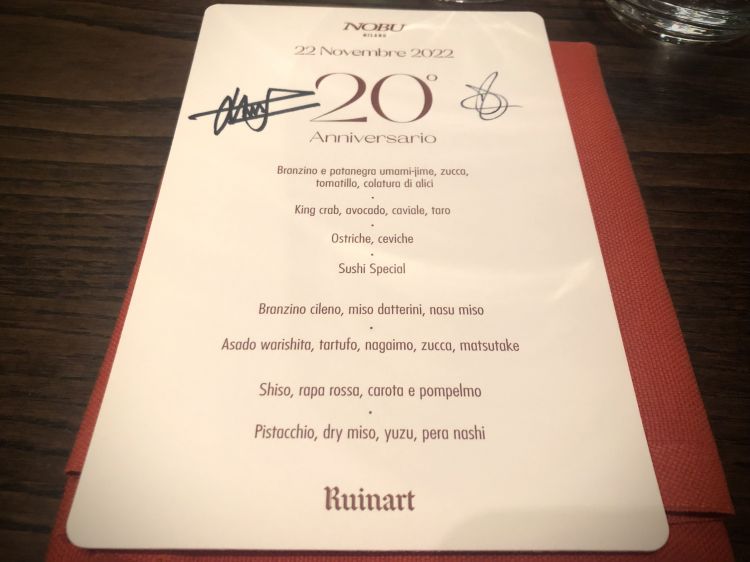
The menu of the exclusive dinner to celebrate Nobu Milan's 20th anniversary
Of Neapolitan origin, Antonio has been Mr Armani’s personal chef for five years and today is Corporate Chef of the Armani Group. For the occasion, he signs an exclusive, unprecedented menu, prepared together with the master; a path that shows how Italy and Japan are only seemingly distant, while they are in fact inspired by the same code of values, by an equal sensitivity in the dialogue with ingredients.
Before we sit down to eat, we meet both, and investigate their respective worlds that meet in simplicity, the most fertile of common territories.
Master Nobu smiles, he has the serene expression of someone who has seen plenty and learned as much. But he is not rigid or strutting; he explains everything with immense calm, starting from the beginning and gradually arriving in the present. Nobu Milano's 20th anniversary celebrations should have taken place two years ago, were it not for the pandemic, which has generated that dense stalemate that everyone has tried to shape in their own image and likeness. For master Nobu, for example, it was by no means a bad time, and he experienced it first hand: 'I have always travelled a lot to follow the different openings around the world. I am usually out about 10 months a year, exposing myself to jetlag, to tiredness: I stay a short time in one place and then leave again. But during the pandemic, something changed: I stopped and started to build my own daily routine. A time to wake up, a time to eat, to exercise, working steadily on my mental and physical balance. I gained a lot of energy, and became well aware that food is a crucial element in 'staying healthy', and that habits are a good practice'. Then, he takes a step back in time and tries to remember Nobu, when it first opened its doors to the Milanese, who were totally unprepared for such an innovative cuisine. Indeed, 20 years ago there was no sushi culture and guests at Nobu arrived well prepared, in their stylish clothes, and almost always asked for what was already familiar to their palates, chicken teriyaki or tempura. But no mention of raw fish.
It has therefore been Nobu's mission to educate to a new idea of Japanese cuisine, to the pleasantness of raw fish, to its wholesomeness, to a new culture of fish preparation. And in this regard, the master recounts two singular, rather recent anecdotes: 'Last week I was in Gothenburg, Sweden, to receive an award from Princess Victoria. The reason behind this gesture amazed me: ‘to have introduced a new way, not only of eating fish, but also of cleaning it, preserving it, and why not, of marketing it, thus boosting exports, and consequently the national economy’. Without straying too far, let's go back to Italy, to Sardinia: here too Nobu has planted roots at Hotel Cala di Volpe in Costa Smeralda. ‘And here too I was surprised when, when I asked the islanders what the typical Sardinian dish was, they all unanimously replied, pork. And the sea? And the excellent Mediterranean fish? At Nobu, that catch, that territorial raw material is a precious resource, it does not take second place'.
All this leads to a milestone in Nobu's cuisine: to offer the freshest and most local ingredients, which is why it has a solid identity throughout the world, but relying, from country to country, on local fresh produce. To the point they grow a good part of the vegetables used by chef Antonio (he takes care of it himself) in the kitchen in their own vegetable garden (Orto di Mimì): ‘Like many other colleagues, in the pandemic, I just couldn't sit still and so, not far from Milan, in the area of Brescia - where I live - I started a vegetable garden to grow Japanese vegetables as well as a series of local vegetables, always following the seasons. The most difficult thing to grow? Wasabi. A small tuber whose complete production cycle lasts two years and requires a series of favourable conditions that are all but simple: wasabi requires little light, running and never stagnant water, it prefers stones to soil, it loves cold weather and, although its inflorescence is important, the fruit it yields is only a handful of cm big'.
Raw materials, high quality: these are the essential aspects, according to chef Matsuhisa, for anyone wishing to do business 'in a big way' today: that the priority should never be turnover or, at least, that this should not come first, compared to the cornerstones of Nobu's philosophy: to form a good team, with a leader capable of listening, stimulating and transmitting passion for work. This is a decisive factor in convincing guests to book again in a Nobu restaurant: 'Many times, when I meet my guests at the end of the service,' comments Matsuhisa, 'they thank me for what I have been able to convey. It is a gesture that I appreciate very much, for which I am immensely grateful, but in fact I feel that it is I who should be thanking them, for having chosen us and having put their trust in each one of us'. So the formula that 'the customer is always right' applies as long as everyone is aware that they have done their job to the best of their ability, always giving their best. By being content, without being too rigid. Nobu Matsuhisa is, in fact, the happy exception to that all-Japanese rule widespread among sushi masters of leaving no margin of choice to the customer sitting at the counter: it is the master who chooses, whether you like it or not. At Nobu’s, instead, every experience ‘is tailor made for the customer, just like an Armani suit’, explains Antonio, satisfied and eager to welcome and listen to any need, with a selection of well-assorted dishes: new, classic, raw, cooked, vegetarian or even vegan, so as to give guests a moment of happiness.
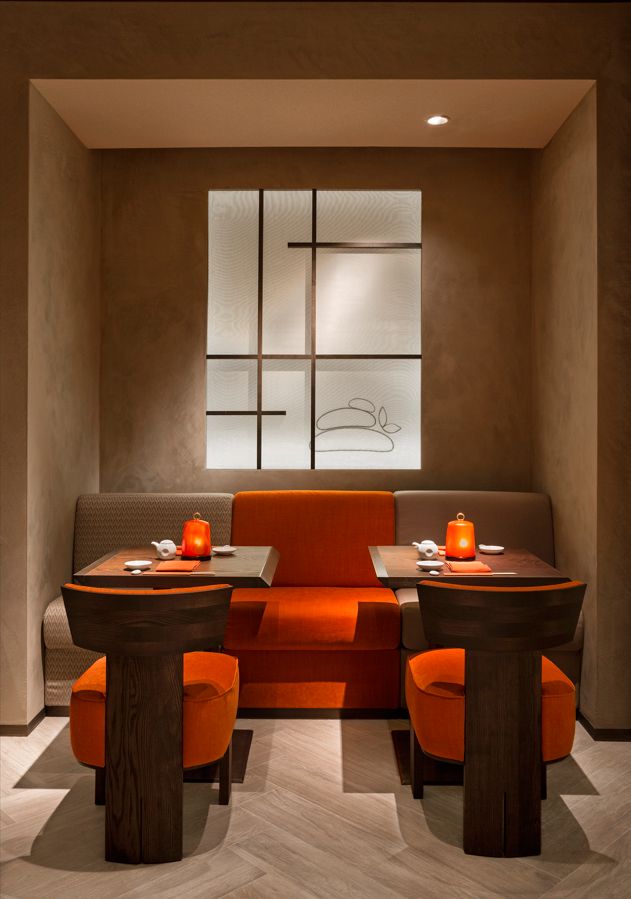
The setting at Nobu Milano reflects Giorgio Armani's essential style, as well as the characteristic features of the interior of a home or restaurant in Japan
The personalisation of the experience, after all, is not the only point of contact with the Armani style: minimalism, neatness, but also that changing from season to season, creating new trends, and just as the fabric, cuts and shapes vary, so does the kitchen evolve, always presenting something new, while remaining faithful to an identity recognisable everywhere. ‘In this place, strongly desired by Mr Armani, there is attention to design, architecture, and to the music chosen to accompany the meal. Without forgetting that the most pleasant sound to listen to is people's laughter, their chatter. I like to read on their faces how each dish moves within them. A design that only takes shape when what nourishes us is, first and foremost, passion, the same passion that leads Giorgio Armani and me to have a soft spot for details: only with passion do you create and define a style,' adds Master Nobu.
Passion, but also 'a lot of stubbornness, a desire to grow and never to close yourself off to others', specifies the Executive Chef of Nobu Milano, Antonio d'Angelo: 'One of Nobu's greatest teachings is to open yourself up to what is going on around you, for example, to consider the opening of a restaurant in your neighbourhood not as a threat, but as an opportunity for you and your guests. Act as a group, as a team: a lesson that is rarely shared'. Opening up to the world, and also opening up to a completely different approach to cooking compared to the one that preceded Chef D'Angelo's entry into Nobu: a good Campanian, from Fuorigrotta, he was raised in a family in which his father had always loved raw materials, and his mother, a fantastic housewife, was already asking you what you wanted for dinner while you were eating your lunch. Thus, the value of tradition, of the ingredient, rests in him in a completely natural way, a value that he reads in Japanese gastronomic culture, 'to the point that, while one day I was walking through the streets of the Tsukiji fish market, I had a flashback and took a leap back in time, to 15 years ago, finding myself at the market in Naples. In both places, fish of considerable size, still alive, was leaping before my eyes. Then I realised how close these two cultures and their respective cuisines were, inspired by simplicity, by the logical combination of a few ingredients. And, led by the hand by two great masters of essentiality - Master Nobu and Giorgio Armani - with my team we define the flavours of Nobu Milano today, in 2022'.
The same minimalism, vigorous and pure, that we feel we went through during the dinner, an exclusive Omakase: the technique, the finesse of the gestures is translated into the form of each course. Each one characterised by an imprint of freshness, sometimes brought by the vegetable, sometimes by the spices that bring us back to the Peruvian nuances of Nobu's cuisine. We grip the ingredient on the palate, a meaty king crab, the assortment of sushi, its intensity changing depending on the fish and the addition of wasabi. The Wagyu asado is delicious, so reminiscent of a braised cheek, while the Japanese tuber ideally replaces a creamy polenta; a pinch of Orto di Mimì and intriguing, delicate ends-of-meal, with a pleasant mixture of fruit and vegetables (carrot, red turnip and grapefruit) in the pre-dessert, and warmer, comforting notes in the dessert at the end (pistachio, nashi pear).
An exquisite journey that we invite you to walk through in our photo-gallery below.
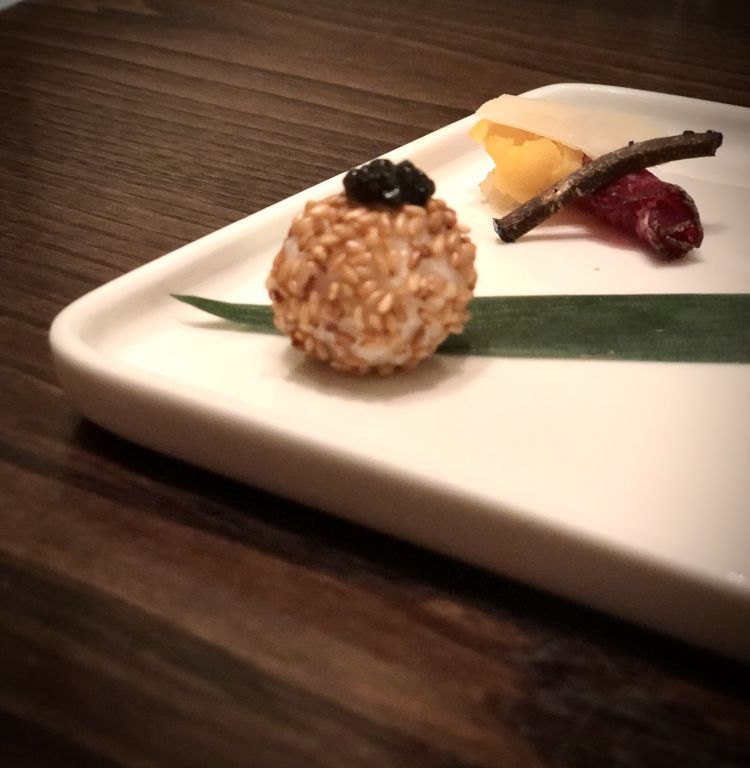
Some of the entrées proposed for the evening: Fried mochi with azuki beans, sesame and caviar and Wagyu bresaola with amazu cauliflower and confit truffle, as well as goma salmon, cooked at 37°C, marinated and served with black sesame and spinach, while to cleanse the palate, Shiso infusion
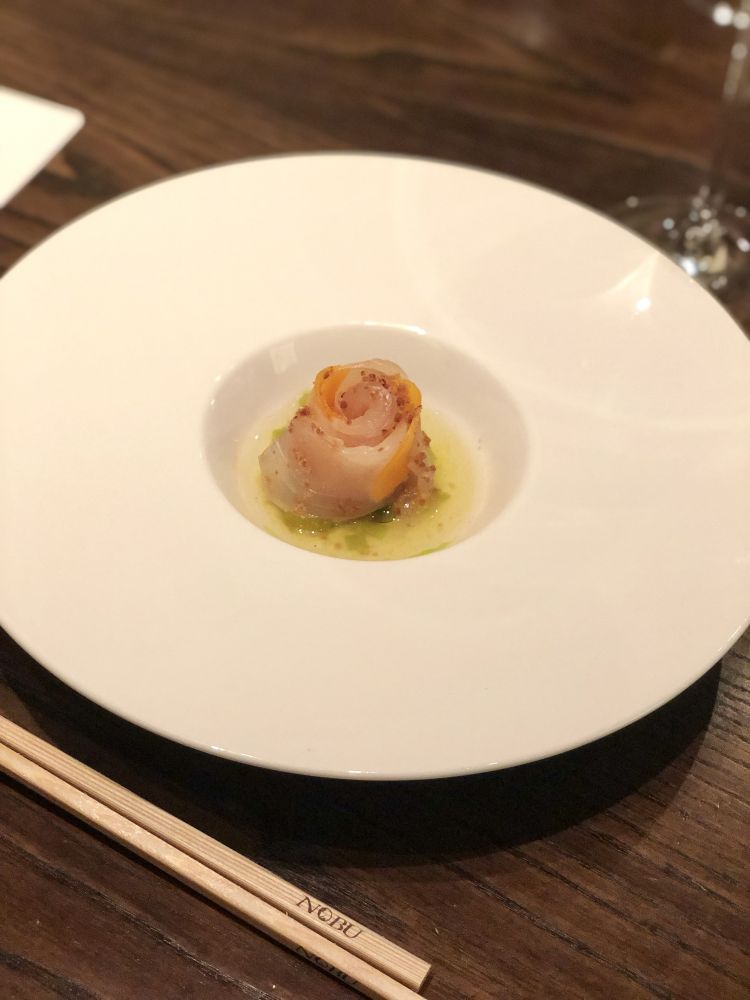
A rose of sea bass, a delicate, almost sweet carpaccio with crispy patanegra, pumpkin brings a pleasant vegetable note as well as texture to the dish, while the green tomatillo gazpacho brightens the palate with juicy acidity
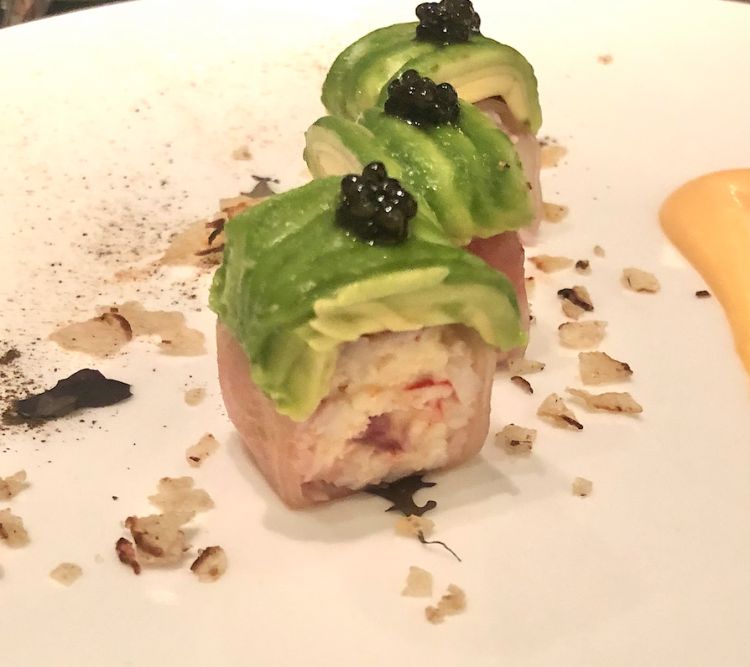
King crab, avocado, caviar, taro
An extremely meaty, long taste; the crab is wrapped in a veil of daikon, enclosed by a light layer of avocado, with a slightly bitter note, contrasted by the fresh tangerine mayonnaise, in which to dip the morsel
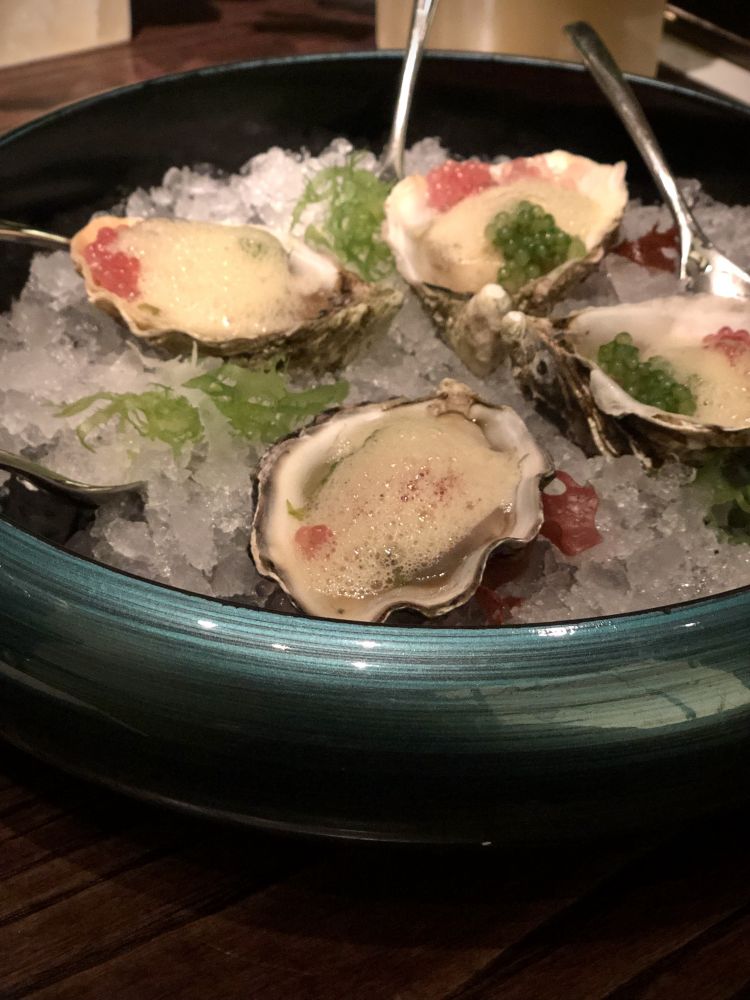
Oysters ceviche
The oysters, lightly cooked in the green egg, are thus, lightly smoked and 'seasoned' with a mousse of ceviche, which ignites a fresh and spicy note on the palate, as well as enveloping it with a pleasant iodine note
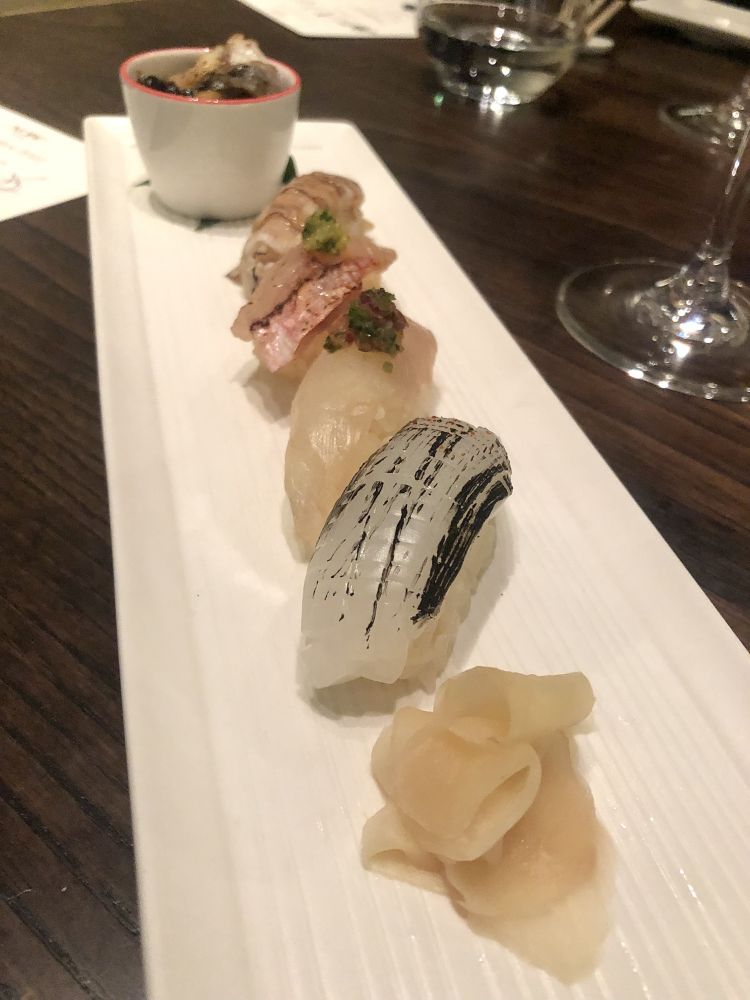
Sushi special
From the top, eel, mullet, grouper and cuttlefish sushi with its ink
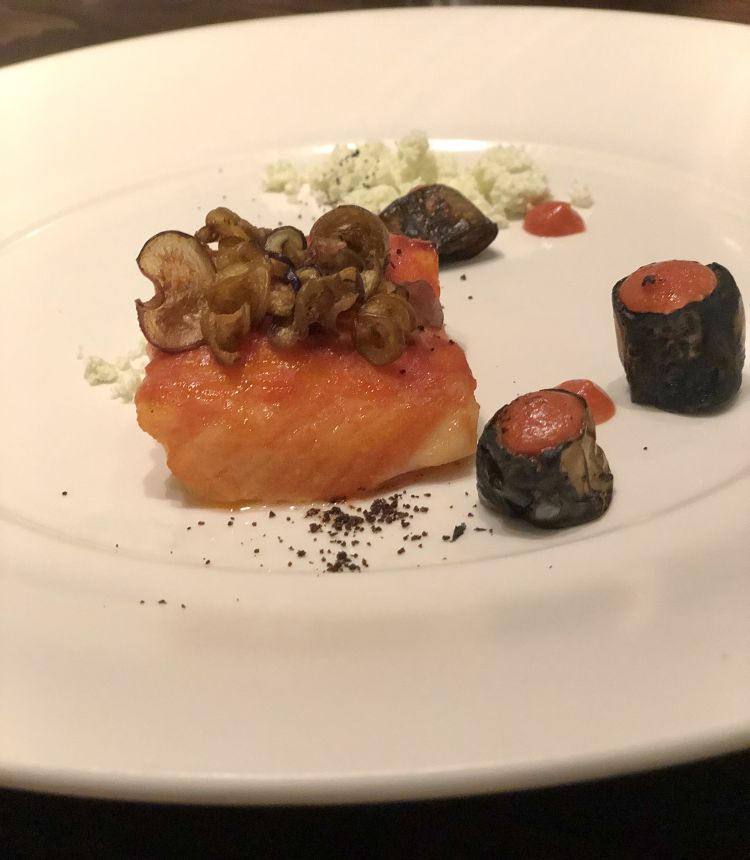
Chilean sea bass with date miso and nasu miso
Not just raw: this cooked dish represents the encounter, the Italian-Japanese embrace. A juicy sea bass absorbs all the Mediterranean flavour of a savoury and vegetal miso of dates; it is strengthened by the smoky tone, almost of burning embers from the aubergine. A dish of strong contrasts, yet in perfect balance
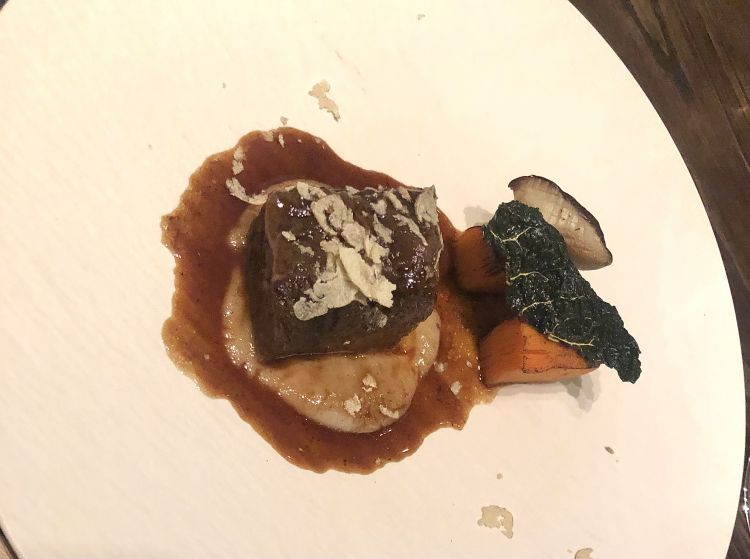
Asado warishita, white truffle, nagaimo, matsutake, white corn
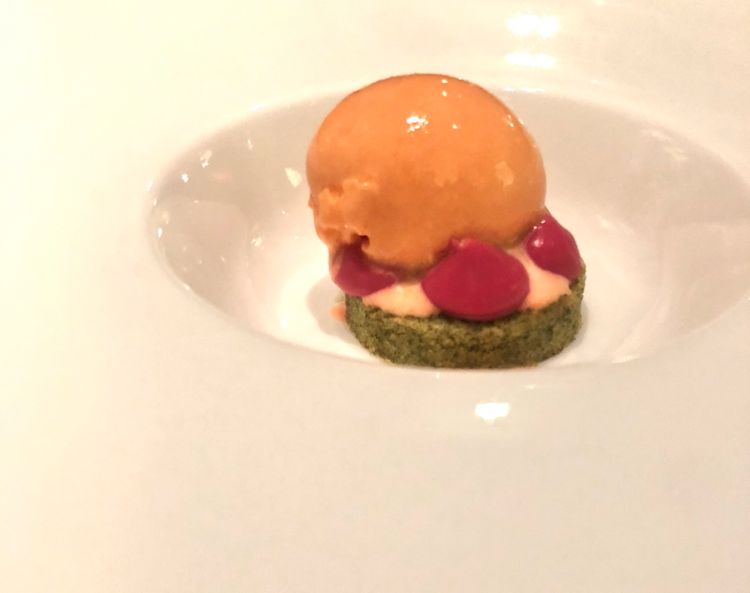
Pre-dessert: a shiso biscuit, enveloping red turnip cream and grapefruit-carrot sorbet. The acid-bitter-cold play and the deliciousness of the turnip cream prepare the palate for the dessert at the end
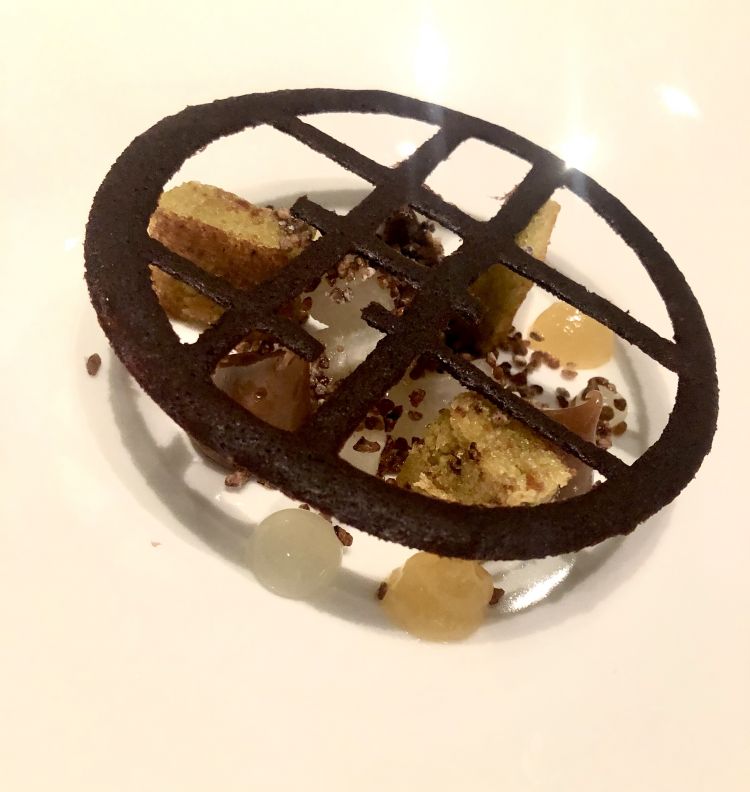
Pistachio, dry miso, yuzu, nashi pear
Translated into English by Slawka G. Scarso